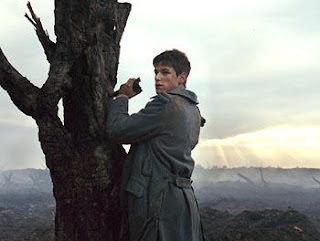
Director: Victor Flemming
Starring: Judy Garland
Perhaps no film ever produced has a more secure place in the collective imagination than The Wizard of Oz. It is a staple of most childhoods and touchstone for many adults. It isn’t just a “kid’s movie,” although a lot of people seem to classify it as such. It’s a deeply resonant film that has as much to say to an adult as it does to a child; it’s a film about discovering who you are and finding your way home, about seeing things the way they are and discovering the truth about that which exists behind the curtain. It is also a terrifically entertaining movie.
It’s difficult to know where to begin talking about The Wizard of Oz, but I suppose the most natural starting point is Judy Garland, who of course plays Dorothy. It’s hard to imagine the film without her, although she wasn’t the first choice for the role (that would be Shirley Temple). The film version of Dorothy is a character who could easily become tiresome to adult audiences because she’s so saccharine, but something about Garland makes you forgive her unshakeable earnestness – especially when she sings. “Over the Rainbow” was voted by the AFI as the best of all film songs, which seems absolutely right to me; it’s one of the few songs that can bring a tear to my eyes.
Dorothy’s wide-eyed innocence plays into the political undertones of the story. Much has been written about the novel which is popularly read as political allegory about capitalism wherein Dorothy is the Everyman, the Tin Man represents industrial workers, the Scarecrow represents farmers, the Yellow Brick Road represents the gold standard, and emerald city represents paper currency. Since the novel was written nearly forty years before the film was made, the politics which informed the former don’t necessarily correspond to the latter. Certainly, Dorothy can still be read as representing the ordinary American people who are at the mercy of political machinations they can’t see (the goings on behind the curtain), in which case the Wizard can be representative of anyone who wields political power, rather than one specific person. The Scarecrow and Tin Man may not represent workers in the same way they did in 1900, but the realization that the Scarecrow, Tin Man, and Cowardly Lion all possessed the qualities they were seeking and could access them if they had faith in themselves would have worked a message of self-reliance to a nation that had not yet been pulled out of the Depression. Like Scarlett O’Hara’s assertion that “Tomorrow is another day,” when Dorothy says, “There’s no place like home,” the line has connotations that would have resonated with the original audiences. Both lines suggest that there’s dawn at the end of the long darkness and that though things may be bad at the moment, it’s worth sticking it out.
But, laying politic readings aside, the film is also very effective as escapist entertainment. It is a testament to the technical achievements of the film that even amongst other films released in 1939, a year widely considered to be one of the best in film history (and considered by many to be the best as titles released that year include Gone With The Wind, The Rules of the Game, Mr. Smith Goes To Washington, Ninotchka, and Wuthering Heights amongst others), it still stands out from the crowd. This is a movie that is vibrant and alive, that commits completely to its creation of another world right down to the little details. To be sure, the land of Oz doesn’t look “real” in the way that more recent imaginary lands can be made to look realistic through CGI, but it works nonetheless. Perhaps because Oz is meant to be a place of a child’s imagination, the constructed nature of the sets with their exaggerations and bright colors just work. Whatever the reason, this movie still looks great, and Oz itself is a land that’s easy to slip into even after you’ve found yourself immersed in Middle Earth and Narnia.
The songs in the film are wonderful and memorable – even if you don’t know the words to “Lollipop Guild” or “If I Only Had A Brain,” I bet you can hum both – and so are the characters. Besides Dorothy and her three companions (four, counting Toto), there’s also Glinda the Good Witch and the Wicked Witch of the West, played by Billie Burke and Margaret Hamilton, respectively. The Wicked Witch is especially memorable – so ruthless that she’d take out your dog, too – and her evil is as indefatigable as Dorothy’s goodness.
Whether you experience this film as political allegory or as a masterful achievement of musical storytelling, whether it exists in your mind as a memory from childhood or as a film you return to as an adult, this is a film that will easily win a place in your heart. Of all the movies I’ve seen, this is the only one I’ve found to be a truly universal viewing experience, and the only one I’ve found that is so universally adored.
















